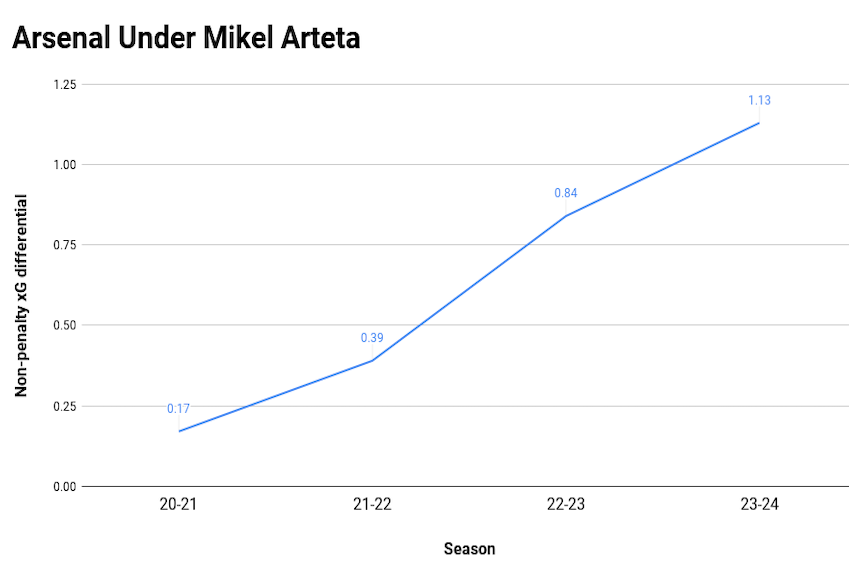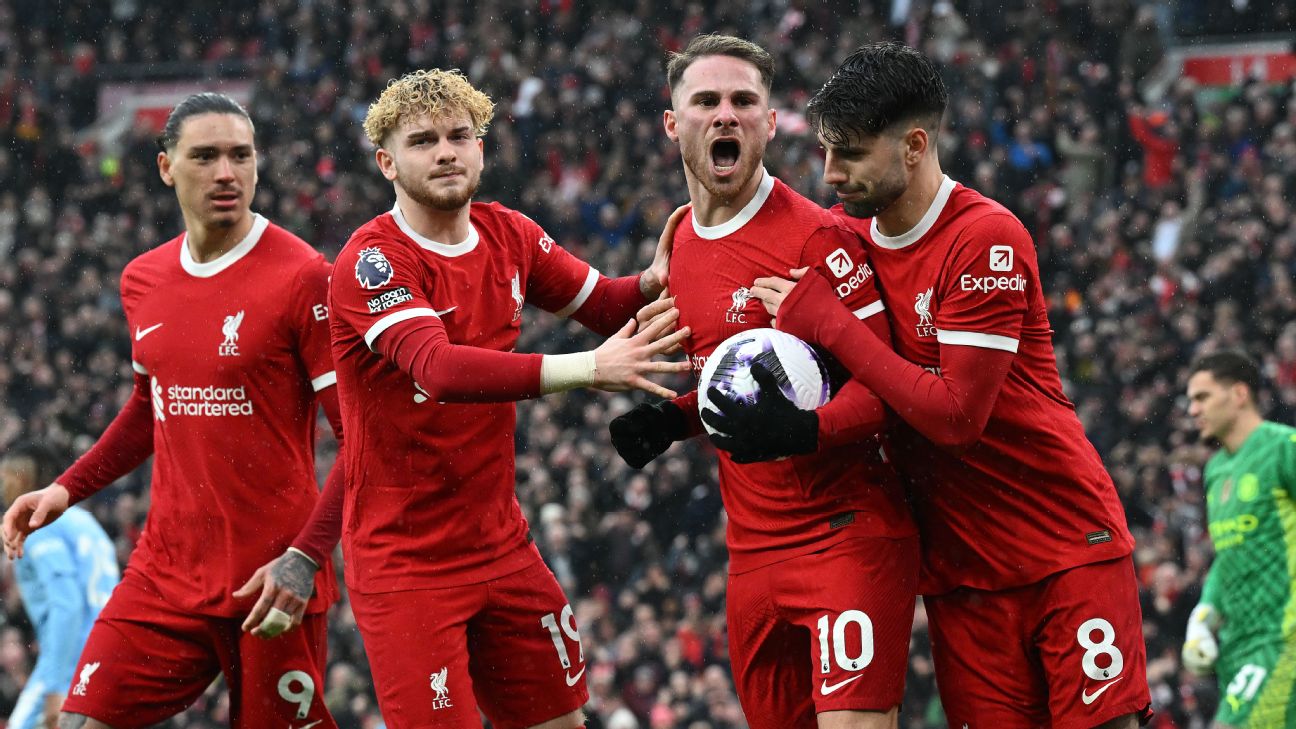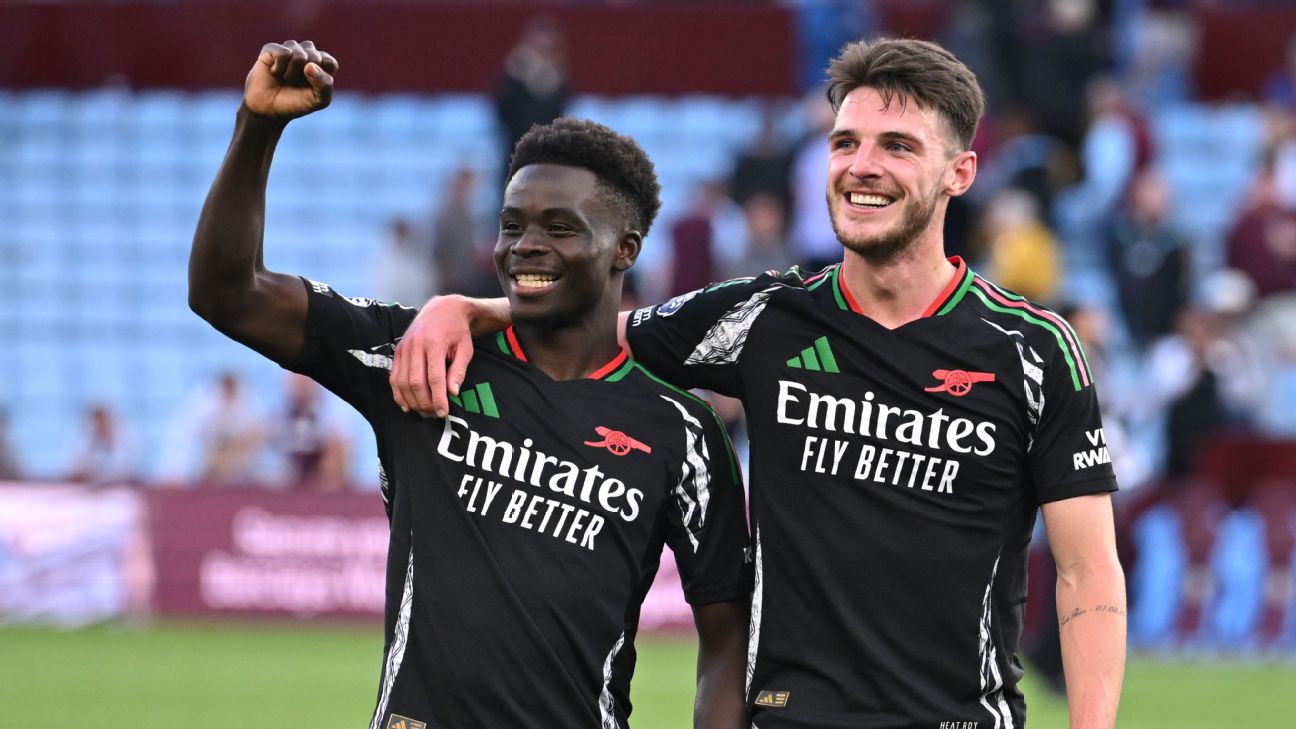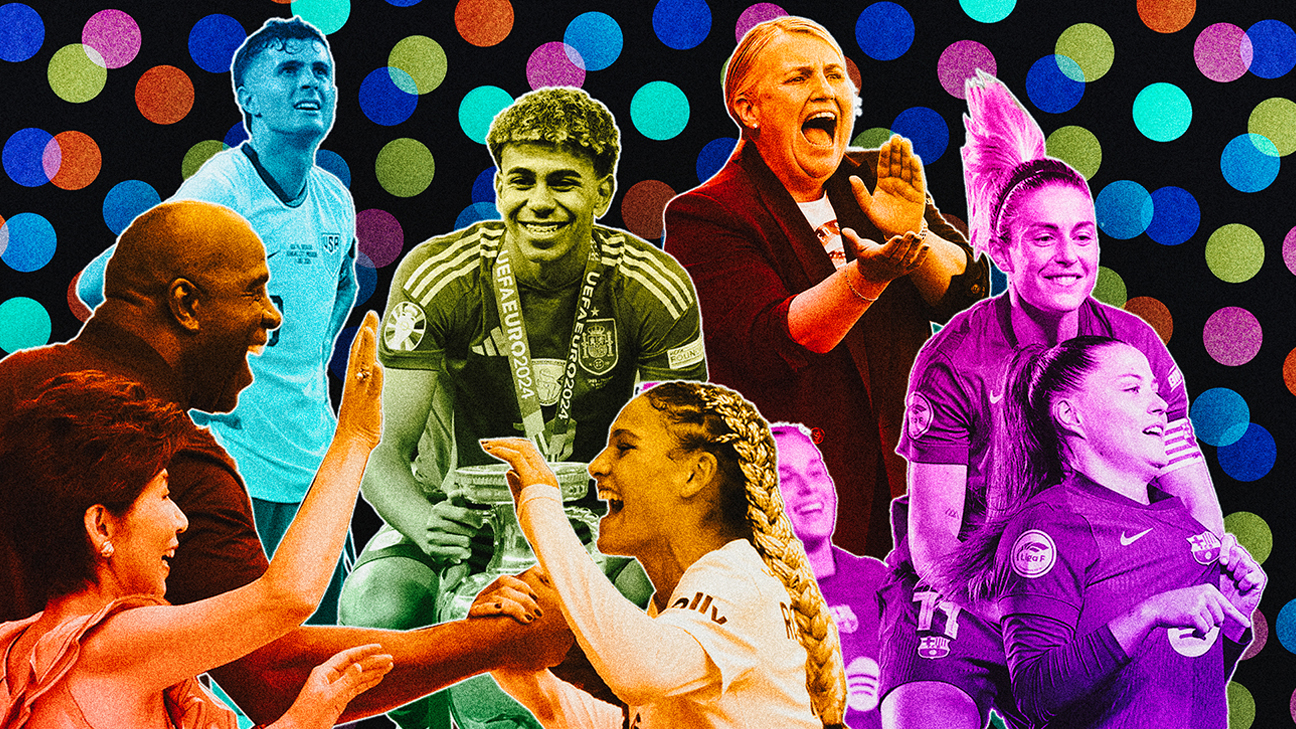No one lost, and everyone lost. The biggest remaining game of the Premier League season — Arsenal vs. Manchester City this past Sunday — was a dud.
In the 2023-24 season, the average match is featuring 27 shots and three-plus goals. Everyone, up and down the table, is scoring goals for fun. But in the second match between arguably the two best teams in the league? Arsenal and Man City combined for 18 attempts and not a single goal. Their three combined shots on target was tied for the fewest of any match this season.
We waited two weeks for that? And for what?
Liverpool’s 2-1 win against Brighton earlier in the day ultimately gave them a two-point lead on the Premier League table over second-place Arsenal, and a three-point cushion on third-place City. But, although Arsenal lost ground in the table, this match wasn’t a failure for them. Their previous two games at the Etihad were a 4-1 and a 5-0 loss — a dull 0-0 draw is progress.
However, this was supposed to be the moment where Man City stopped messing around, flipped the switch and eviscerated the rest of the league like they always do. Instead, Sunday’s game — combined with the match at Anfield on the previous Premier League match day — seemed to confirm the opposite: both Arsenal and Liverpool have caught up to Manchester City.
How did Man City — the team that won the treble just a year ago and was rightfully referred to as the greatest English club side of all time — lose their lead so suddenly? It starts and ends with what happened last summer. Here’s why and how one transfer window from last year is deciding the Premier League title race right now.
How Man City got worse and their rivals got better
By the simplest performance metric we have, this is the worst Manchester City team of the Pep Guardiola era.
Here is their non-penalty expected-goal differential for all of Pep’s seasons in the Premier League:

The reason Guardiola is the defining coach of the modern era — someone who seems to have outlasted multiple waves of managerial rivals — is not that his teams are efficient in front of goal, or because they find ways to win matches they shouldn’t, or because they know how to play in big games, or anything else intangible like that. No: his teams always win because his teams create better chances than their opponents, by a bigger margin than their opponents, over and over and over again.
If we write off his first season at Man City as a transition year, then Guardiola’s teams have only lost the league title twice. The first was when he managed Barcelona in 2012 and they lost to a Real Madrid team that won 100 points in LaLiga, and the second was in 2020 to a Liverpool team that won 99 points in the Premier League. Madrid’s 100 points were a LaLiga record, while Liverpool’s 99 points are the second-best mark in the history of the Premier League. Unless a team has been having one of the best seasons the sport has ever seen, it hasn’t been enough to topple any of Guardiola’s teams at Barcelona, Bayern Munich, or Manchester City.
Stats Perform only has advanced data for Guardiola’s final two Barcelona seasons, but across his entire managerial career, his teams have never been worse at controlling the balance of chances than they are this year. At Bayern Munich, their worst non-penalty expected-goals differential across a full season was plus-1.12 in 2015-16. At Barca, it was plus-1.4 in 2010-11. This season, it has dipped slightly below 1.0.
Their rivals, meanwhile, have both bounced up near or above that number. Arsenal’s steady, impressive improvement under manager Mikel Arteta continues. The data for each of his full seasons as manager:

And in Jurgen Klopp’s final season at the helm, Liverpool have returned to somewhere near but still below the level of the title-challenging teams of seasons past — despite losing almost every key contributor on the roster not named Virgil Van Dijk to injury for significant periods of time:

It all adds up to a situation we’ve rarely seen recently in the Premier League: with nine games to go, Manchester City are no longer the favorites to win it all. Before this weekend’s games, per the implied odds from ESPN BET, Man City had a 41% chance to win the league, while Liverpool were at 33% and Arsenal at 26%. After Sunday’s matches, Liverpool are now the favorites at 42%, while Arsenal’s odds improved slightly, too — up to 27%. City’s chances, though, have dropped all the way down to 31%.
Why Man City got worse and their rivals got better
Players win games. Over the summer, Arsenal and Liverpool acquired much better players, and Manchester City did not. The story of this season so far might just be as simple as that.
Although I was skeptical of the massive transfer fees that Arsenal paid to bring in both players, Kai Havertz (€75 million) and Declan Rice (€116.6 million) have both quickly become key contributors for one of the best teams in the world.
In fact, Rice might be the key contributor. Since arriving from West Ham, he’s played 95.3% of the league minutes for Arsenal — second only to the 100% played by their outstanding center back William Saliba. The 25-year-old Rice is second on the team in progressive passes and first in tackles+interceptions. He’s also scored six goals, added five assists, and played multiple roles in the midfield. He’s a star, and they’ll build the team around him for the next half-decade.
Havertz struggled earlier in the season while playing in the midfield, but Arsenal’s supernova 2024 — they still haven’t trailed in a league match this year — coincides with the 24-year-old moving to the position, center forward, he played when he scored the winning goal in the Champions League final. Although he might never score goals at an elite rate, he’s a fantastic facilitator, presser, and off-ball mover. His teams just seem to play better when he’s sitting up top. His size, too, has allowed Arsenal to occasionally give up on the pretty passing and simply bomb it high and long in order to move play into the attacking third.
In goal, it’s not quite as clear that David Raya has been an upgrade over goalkeeper Aaron Ramsdale. Their shot-stopping numbers with Arsenal are similarly below average, but he came up huge in the Champions League round-of-16 shootout against Porto. And he’s given the ball away less often than Ramsdale while progressing it forward more often. More simply, though, he’s simply just played a lot: 79.3% of the minutes since joining from Brentford after the season had already begun.
With Liverpool, this was the summer they were supposed to sign Jude Bellingham and tried to sign Moisés Caicedo. Despite landing neither, they still managed to totally rebuild their midfield in a single offseason after letting stalwarts like Fabinho and Jordan Henderson go.
Liverpool brought in Alexis Mac Allister from Brighton for €42 million, and he has been Liverpool’s fourth most-used player (73.1% of the minutes) and most-used midfielder. Previously thought of as a creative midfield player, he’s spent much of the season playing as the team’s deepest-lying midfielder, and he leads the team in tackles+interceptions this season. Outside of Van Dijk, he’s been the most consistent player on the team this year.
Their biggest summer signing, Dominik Szoboszlai, joined from RB Leipzig for €70 million, and although he missed much of the winter through injury, he has still played in 70% of the available minutes this season. He’s one of the best pressers in the league and he’s added a bit of everything on offense: shots, chance creation, ball moving, and off-ball movement.
Liverpool’s third-most-used midfielder, too, is a summer signing — this one outside of the club’s typical 25-or-younger age range. After missing out on Caicedo, the club surprised everyone by pivoting to a cheaper deal for 30-year-old Wataru Endo (€20 million), previously the club captain at Stuttgart. After spending the first half of the season in a backup role, it seems like he’s now the first-choice defensive midfielder for the team that’s the favorite to win the Premier League.
While Liverpool and Arsenal came into the summer transfer window with clear plans, it’s really still unclear what Manchester City were trying to accomplish.
The two big losses from the treble-winning Man City team were Ilkay Gündogan, a versatile box-crashing midfielder who didn’t need to be on the ball, and Riyad Mahrez, a traditional cut-in-from-the-right winger. And the big weaknesses within the squad seemed to be: no backup for Kyle Walker, no backup for John Stones, and no backup for Rodri. Walker’s defensive range allowed the team to take more risks on the ball. Stones’ ability to step into the midfield and basically be a world-class midfielder essentially allowed Man City to play an extra center back and midfielder at the same time. And Rodri is just the best holding midfielder in the world. He’s great at everything.
Given all of that, it’s hard to understand why Man City allowed last summer to play out the way it did.
Man City spent €90 million to acquire Josko Gvardiol from RB Leipzig. Many considered him to be the best young center back in the world, but Man City wasn’t a team wanting for center backs. On top of that, the jump from Germany to England is a big one, and he’s mostly played as a left back this season.
City’s next biggest signing was Matheus Nunes for €62 million from Wolves. Perhaps they thought he could be their Gundogan replacement, but in the Premier League, he’d never made much of an impact beyond his ability to carry the ball. Midfielders are tricky to judge, but his passing numbers were average-to-bad and there was little to suggest that his presence on the field helped Wolves win matches. He’s featured in less than half of the available minutes this season.
Was summer signing Mateo Kovacic supposed to be the Gundogan replacement, then? The €29.1 million acquisition from Chelsea has always done his best work by dropping deep and pushing the ball up the field. But City don’t need players to push the ball up the field — they need players who can create space for the ball to be pushed into up the field. Plus, Kovacic is 29, which means City ran the risk of bringing him in right as he began to decline.
City’s final signing was Jérémy Doku for €60 million from Stade Rennais. He’s been electric at times, and his ability to push the ball into the penalty box at his feet is unmatched anywhere in the world. He’s carried the ball into the box 117 times this season, while no one else in Europe’s “Big Five” top leagues has done it more than 73 times. He’s played more than any of the other summer signings (72.4% of the minutes), but he also plays the same position as one of last season’s stars who is still at Man City: Jack Grealish. Unlike the departed Mahrez, neither Doku nor Grealish seem comfortable on the right wing. And if they are, we haven’t seen Guardiola give either of them an extended run in that role.
At the time, Man City’s summer looked worse than Liverpool’s or Arsenal’s. The Gvardiol signing was a risk, Nunes had never looked anything like a player capable of contributing to the best team in the world, Kovacic was aging out of his prime, and for all of his promise, Doku had still never contributed to more than eight total goals in a single season.
Since then, it’s gotten even worse. Gvardiol has struggled at left back and isn’t a first-choice player. Nunes or Kovacic aren’t first-choice players either. Doku might be, and City have been better with him on the field than off, which isn’t true for any of the other three. But there’s still a question of whether he’s a better fit than Grealish.
With Arsenal’s and Liverpool’s major additions, though, there aren’t any questions. Arsenal are better with Raya and Rice and Havertz on the field. Liverpool are better with Mac Allister and Szoboszlai and probably Endo, too.
Even both of their “failed” signings still hold plenty of potential for the future. Arsenal’s versatile defender Jurriën Timber is only 22, and Liverpool’s fourth midfield acquisition, Ryan Gravenberch is only 21. Timber has missed the season due to injury, while Gravenberch (32.4% of the minutes) has mostly been a backup. He’s still quite raw, but has also been quite productive on the ball when he’s been on the field.
Of course, this is all relative. Manchester City could still win the league, they’re still favorites to win the Champions League, and pretty much every other club in the world would kill to have the season they’re currently having. But unlike in almost every other season in which Pep Guardiola has managed a top-level soccer team, his team isn’t the clear best team. This Man City team isn’t one that’s only beatable by a historic, unsustainable, unrepeatable performance from someone else. No, this season Manchester City are just one of the three best teams in the Premier League.
There are a bunch of reasons we are where we are right now, but the biggest one might just be this: Manchester City spent €240 million on transfer fees over the summer and got worse. Arsenal spent a little bit less and Liverpool spent a lot less, but both of them got a lot better.



